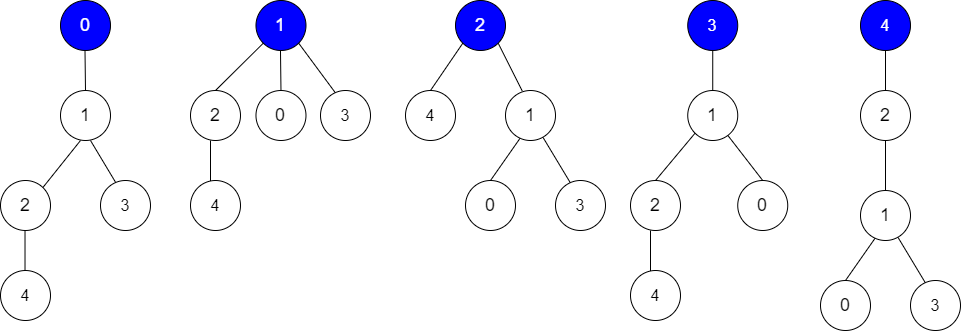统计可能的树根数目
难度:
标签:
题目描述
Alice has an undirected tree with n nodes labeled from 0 to n - 1. The tree is represented as a 2D integer array edges of length n - 1 where edges[i] = [ai, bi] indicates that there is an edge between nodes ai and bi in the tree.
Alice wants Bob to find the root of the tree. She allows Bob to make several guesses about her tree. In one guess, he does the following:
- Chooses two distinct integers
uandvsuch that there exists an edge[u, v]in the tree. - He tells Alice that
uis the parent ofvin the tree.
Bob's guesses are represented by a 2D integer array guesses where guesses[j] = [uj, vj] indicates Bob guessed uj to be the parent of vj.
Alice being lazy, does not reply to each of Bob's guesses, but just says that at least k of his guesses are true.
Given the 2D integer arrays edges, guesses and the integer k, return the number of possible nodes that can be the root of Alice's tree. If there is no such tree, return 0.
Example 1:

Input: edges = [[0,1],[1,2],[1,3],[4,2]], guesses = [[1,3],[0,1],[1,0],[2,4]], k = 3 Output: 3 Explanation: Root = 0, correct guesses = [1,3], [0,1], [2,4] Root = 1, correct guesses = [1,3], [1,0], [2,4] Root = 2, correct guesses = [1,3], [1,0], [2,4] Root = 3, correct guesses = [1,0], [2,4] Root = 4, correct guesses = [1,3], [1,0] Considering 0, 1, or 2 as root node leads to 3 correct guesses.
Example 2:

Input: edges = [[0,1],[1,2],[2,3],[3,4]], guesses = [[1,0],[3,4],[2,1],[3,2]], k = 1 Output: 5 Explanation: Root = 0, correct guesses = [3,4] Root = 1, correct guesses = [1,0], [3,4] Root = 2, correct guesses = [1,0], [2,1], [3,4] Root = 3, correct guesses = [1,0], [2,1], [3,2], [3,4] Root = 4, correct guesses = [1,0], [2,1], [3,2] Considering any node as root will give at least 1 correct guess.
Constraints:
edges.length == n - 12 <= n <= 1051 <= guesses.length <= 1050 <= ai, bi, uj, vj <= n - 1ai != biuj != vjedgesrepresents a valid tree.guesses[j]is an edge of the tree.guessesis unique.0 <= k <= guesses.length
代码结果
运行时间: 251 ms, 内存: 67.9 MB
/*
* 思路:
* 1. 构建树的邻接表表示。
* 2. 使用DFS遍历树,找出每个节点作为根时的父子关系。
* 3. 使用Java Stream API计算每个节点作为根时正确的猜测数量。
* 4. 如果正确的猜测数量不小于k,则该节点可能成为树的根。
*/
import java.util.*;
import java.util.stream.*;
public class Solution {
public int rootCount(int[][] edges, int[][] guesses, int k) {
int n = edges.length + 1;
List<Integer>[] tree = new ArrayList[n];
for (int i = 0; i < n; i++) {
tree[i] = new ArrayList<>();
}
for (int[] edge : edges) {
tree[edge[0]].add(edge[1]);
tree[edge[1]].add(edge[0]);
}
int[] parent = new int[n];
Arrays.fill(parent, -1);
dfs(tree, parent, 0, -1);
return (int) IntStream.range(0, n)
.filter(i -> countCorrectGuesses(parent, guesses, i) >= k)
.count();
}
private void dfs(List<Integer>[] tree, int[] parent, int node, int par) {
parent[node] = par;
for (int neighbor : tree[node]) {
if (neighbor != par) {
dfs(tree, parent, neighbor, node);
}
}
}
private long countCorrectGuesses(int[] parent, int[][] guesses, int root) {
return Arrays.stream(guesses)
.filter(guess -> parent[guess[1]] == guess[0])
.count();
}
}
解释
方法:
时间复杂度:
空间复杂度: